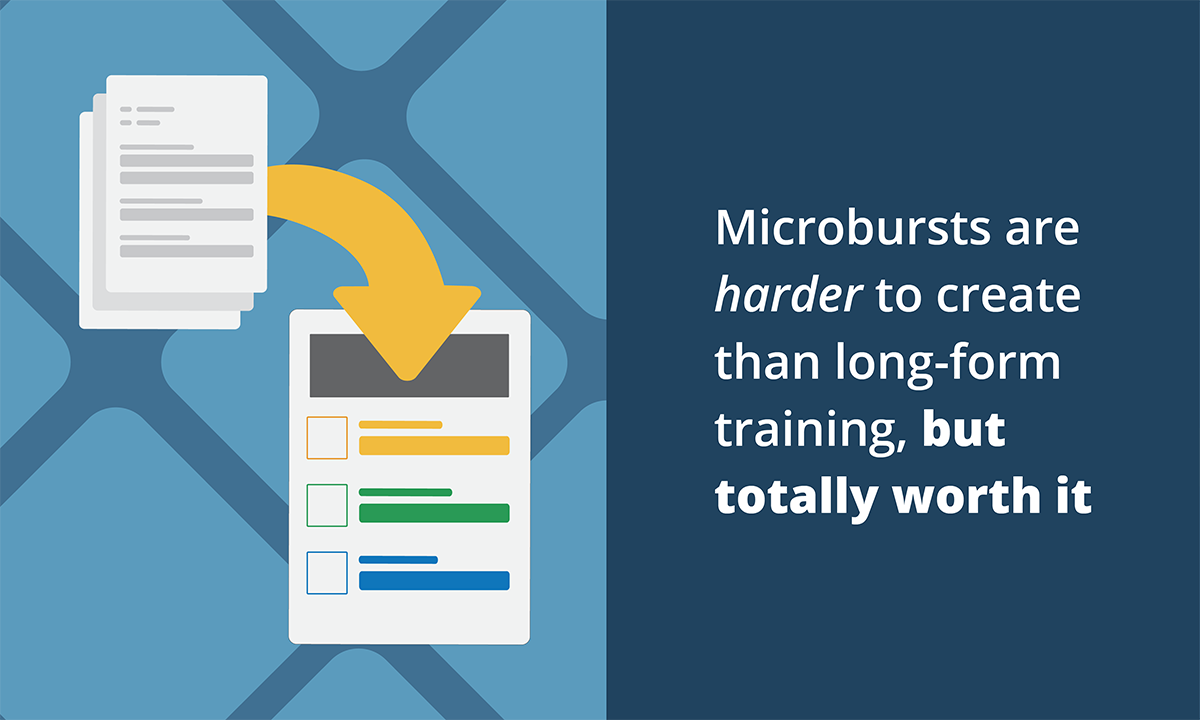
Microbursts are harder to create than long-form training, but totally worth it
There are so many myths when it comes to effective training and comms. Every time I read something about adult learning theory and how some people learn by reading, others with pictures, and others by hearing, I roll my eyes. 🙄 It’s a distraction because most of what you hear has been debunked. We even devoted an entire blog about these myths that I won’t rehash here.
What you do need to know is that, while there isn’t a magic bullet when it comes to training, there is a secret sauce. And to make it work, you need all these ingredients:
- Repetition - communicating the same message multiple times 👯
- Elaboration - building on what is already known 🏗️
- Associations - connecting the message with what employees do 🤝
- Multiple modes - people learn by doing, seeing, and hearing (not one or the other) ♻️
- Short sessions - brains can only hold a small amount of information at a time and need sleep to process and store it into long term memory ⏱️
And that’s the “secret:” humans can only remember three or four things at a time. This is called “working memory.” If you want people to remember the information you’re sharing with them, you need to help them move it from their short-term to long-term memory.
 Source: Schitt's Creek
Source: Schitt's Creek
All this results in retrieval, or in non-nerdy speak, the ability to remember stuff when it’s needed. That’s the science behind what makes Broadcat’s job aids, under-two-minute videos, reminder graphics, mini-modules, talking points, and email templates so powerful.⚡️
They repeat consistent messages, build on each other, make connections between what your employees are doing and what’s compliant/expected, they’re brief and to the point, and—when used together in a training campaign—cover auditory, visual, and kinesthetic learning. And that’s no coincidence; it’s by design! (Pro Tip: You can take our mini-modules for a spin as a standalone bundle or as part of your Compliance Design Club Membership).
The takeaway here is that one-hit-wonders might be great for nostalgic playlists, but they suck for compliance training. Don't give your teams a single, hour-long training and expect them to play it on repeat for the rest of their lives. Developing compliant behaviors is all about creating a variety of hit singles that folks can refer to based on the situation they're in. It takes work and creativity, but it's totally worth it if you’re in the business of influencing people to do the right thing. And if you’re reading this, then that’s probably you!
The thing is, knowing the recipe doesn’t mean you’ll make delicious sauce. It’s an art as much as a science. And in my experience, the part that compliance people struggle the most with is brevity.
Brevity and the Compliance Sauce
It may seem counterintuitive, but developing shorter, simpler communication (microbursts!) is waaay harder than creating lengthy modules, emails, presentations, and articles. As someone famously said: If I had more time, I would have written you a shorter letter. (I think it was that math guy, Blaise Pascal.)

Not to brag or anything, but the shortened version would be 42 🤓 Source: Jack & Jack
Why? It’s easy to do a data dump from your brain and share everything you know about a subject. It takes more effort to think through what is truly important, what’s fluff, and then to parse what lies between. 🤔 Here are some tips to keep in mind while reviewing training materials:
- What you think is important might not be. Focus on your audience and what they do that creates or mitigates risk on the job. It’s not always easy deciding what’s relevant to a role other than your own; it’s easier to train all employees on everything and every what-if scenario “just in case.” Fight the urge!
- Now that you've aligned your core message to your audience and answered the question, “What’s in it for you?,” you have to edit, edit, and edit some more, taking care to use plain language, simplify sentences, and organize the information in a way that is most practical for your readers. (If you’re a customer, you can grab our Writing for Compliance guide to help you with this process.)
- Don't fall into the "good enough" trap! You may not feel like you have the time to improve on a meh-good-enough draft, but if you’re going to prove your worth to the business to grow your credibility and resources, you better make it a priority!
Why spend so much effort refining your content? Well, employee time is money. In this case, asking hundreds or thousands of employees to take 30 minutes to read and process the content in a training module—or even 15 minutes to read a policy or newsletter article—adds up quickly to lots of $$$ when multiplying that time by compensation packages. 💸
That’s not to say spending money training your employees is a bad thing. It’s great when you see results (in econ speak, when the cost-benefit analysis is in your favor). Proving the value of your training efforts takes planning, and means reaching out to IT, audit, HR, and other groups to identify metrics to track and benchmark against. (And then making sure you don’t forget to look back and benchmark your training once it’s over.)
By the way, if you’re using completion rates or quiz questions at the end of a course to measure effectiveness, I have some bad news for you. Seventy-five percent of that information will likely be forgotten in a week (Doyle & Zakrajsek, 2019), and it doesn’t get any better as time goes on. There’s debate on why this happens, but there’s agreement that information recall decays rapidly.
Ready to Serve Up That Sauce!
Now you have the recipe, step-by-step instructions, and understand the science behind what you’re making. All that’s left is practice. Just like the training you're creating, repetition makes it easier to get it right.
Take an existing long training course and start transforming it into a mix of short, practical tools such as mini-modules, process-embedded checklists, reminder posters, and/or videos delivered over the course of the year.
This transformation will result in content that is:
✅ Short form and covers one or two things max
✅ Audience-focused and behavior-based
✅ Delivered through multiple communication channels and methods
✅ Repetitive and builds on what they’ve already learned
All that’s left is showcasing the results of your labor! Track the impact this new approach has on the risk metrics you wanted to improve. And then, tackle the next hour-long (or more!) course. One bite at a time!

